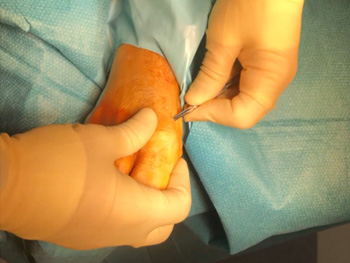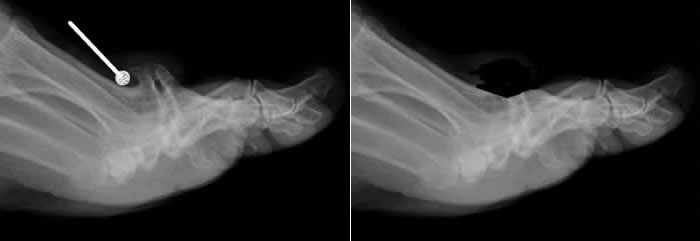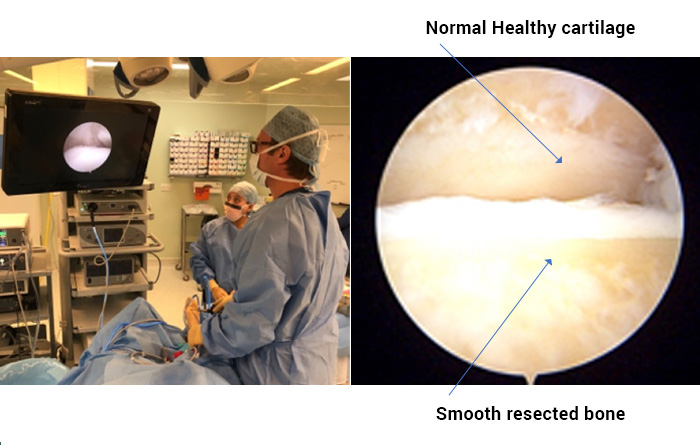Hallux Rigidus (MIS Cheilectomy)
Minimally Invasive Cheilectomy
This operation is for a stiff painful big toe joint (Hallux MTP joint), which is minimally affected by arthritis. The surgery removes the obstructing spurs.

This is performed using minimally invasive techniques, through a tiny (3mm) incision over the top of the joint.
The soft tissues are lifted off the spurs with a special elevator.
The spur and the top ¼ of the joint are removed with a specialised burr (3.1mm wedge burr).

Xrays are taken during the procedure to confirm the bone has been adequately cleared.

Arthroscopy of the joint can be performed to ensure that the surgery has addressed all the arthritic areas.
The surgery is routine, and this is one of the more minor operations. Recovery is rapid but the swelling may last for several weeks.
Preparation for Surgery
You should have received a letter detailing the codes and costs for the surgery and giving instructions on where to go and at what time. Please check these details carefully as you will be liable for any costs not covered by your insurers.
You will need to be nil-by-mouth – No food for 6 hours before surgery. Clear fluids can be taken for up to 2 hours before the operation.
MRSA status
Before or on admission to hospital a nasal swab will be taken to screen for MRSA. There is a small chance this is positive. If so your operation will be moved to the end of the list or rarely to another day to prevent cross infection.
Anaesthetic
The surgery is normally a daycase procedure, performed under a general anaesthetic with local anaesthetic for additional pain relief. It is not normally a particularly painful operation and most patients report minimal discomfort afterwards.
Risks of surgery
Swelling & Stiffness
Initially the foot will be very swollen and needs elevating. It will be stiff in the immediate postoperative period but movement should return rapidly (2-4 weeks). The movement should improve with surgery, but this is not always the case. The swelling will disperse over the following weeks but may still be apparent at 6 months.
Infection
There is always a risk of infection with surgery but it is very low in this type of surgery as the wound is so small. If there is an infection, it normally resolves with a course of oral antibiotics.
Nerve Injury
There is a v small nerve close to the incision, which supplies the skin to the side of the toe. This may be bruised or even permanently injured. This will leave a small patch of numbness on the side of the toe.
Continued Pain
The symptoms in this toe are due to either biomechanical abnormality in the joint (not arthritis) or they may be the first signs of arthritis in the toe. The aim of the surgery is to improve the movement in the joint and relieve pain. Overall the results from surgery are excellent.
However, if the joint has some arthritis, this may be exacerbated by the surgery and cause continued or increased pain. It is not possible to tell, prior to surgery, whether this is the case.
If symptomatic arthritis does occur joint later, then a further operation will be necessary.
Immediately after surgery
Following surgery, the toe is protected in a specialised dressing and postoperative shoe. The dressing can be reduced to a simple elastoplast at 3 days.
You will be seen by a physiotherapist on the ward, who will advise on walking and early rehabilitation. You will be allowed home only when you are comfortable and capable.
Recovery from surgery
Elevation of the foot (above the pelvis) for the first 3 days is vitally important to prevent infection. Naturally, small periods of walking and standing are necessary.
This type of operation and the postoperative shoe allow weight bearing (walking) immediately. The postoperative shoe can be discarded once the dressings have been reduced. If ordinary footwear is still uncomfortable then a hard soled sandal is often a good idea. The swelling may take 1-2 weeks (rarely longer) to settle enough to wear normal shoes.
Exercise and sport can start after one week, but may take 1-2 months to become comfortable.
Swelling - many patients worry about the swelling. It is a natural response to the surgery and will take a few months to go.
Physiotherapy: This can be started after 3-7 days.
Pain relief and take home medications
You will be given high doses of prescription painkillers to take home. Use these for the first 2-3 days and reassess.
Weight-bearing
You can walk on the foot immediately, in the protective shoe - the physiotherapist will assess and help you.
Washing and Bathing
It’s important to keep the dressing completely dry – the nurses will show you how to do this with a waterproof cover.
Activity and time off work
In general, unless you have a role that involves a lot of standing, walking or other activity it is possible to return to work after a few days.
When can I start to drive again?
The DVLA states that it’s the responsibility of the driver to ensure they are always in control of the vehicle. Driving should be possible after 3 days, but only if normal shoes are worn.
It remains your responsibility to drive safely and you should also check with your vehicle insurer to confirm you are covered.
Results of surgery
The short to mid-term results of this type of surgery are very good and the majority of patients get excellent relief for many years. It may be better to consider this as an interim procedure, as the underlying arthritis will continue to affect the joint and so symptoms can often recur after several years